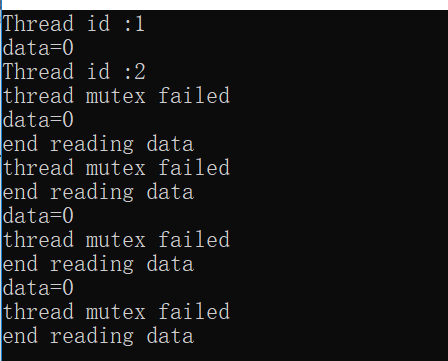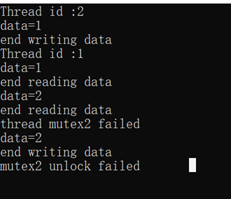死锁就是不同的程序在运行时因为某种原因发生了阻塞,进而导致程序不能正常运行。阻塞程序的原因通常都是由于程序没有正确使用临界资源。
我们举个日常生活中的例子来比喻死锁。我们把马路上行驶的汽车比作运行着的程序,把马路比作临界资源,如果有两辆汽车相互碰撞,就会把车停在马路上,这样的话他们一直占用着马路这个临界资源。其它的汽车不能正常通过马路,于是整条路上的汽车都无法在马路上正常行驶,马路也被汽车堵的水泄不通。整个交通都瘫痪了,这就是“死锁”。造成死锁的原因就是发生车祸的汽车占用了马路这种临界资源,以至于其它汽车无法在马路上正常行驶。
在实际的程序中造成死锁的原因有两种:
1 同一个线程对已经加锁的互斥量再次加锁;
2 线程A对互斥量一加锁,同时等待互斥量二被解锁;而此时,线程B对互斥量二加锁,同时等待互斥量一被解锁;
首先来看第一种现象:
int value=0;
pthread_mutex_t mutex_value_tmp1=PTHREAD_MUTEX_INITIALIZER;
void read_data(){
printf("data=%d ",value);
printf("end reading data ");
}
void threading_func1(){
int i=0;
int res=0;
pthread_t thread_id;
thread_id=pthread_self();
printf("Thread id :%d ",thread_id);
while(i<4){
res=pthread_mutex_lock(&mutex_value_tmp1); #第一次加锁
if (res !=0){
printf("thread mutex failed ");
}
read_data();
res=pthread_mutex_lock(&mutex_value_tmp1); #第二次加锁
if (res !=0){
printf("thread mutex failed ");
}
res=pthread_mutex_unlock(&mutex_value_tmp1); #释放锁;
printf("res=%d ",res);
if (res !=0){
printf("mutex unlock failed ");
}
Sleep(2000);
}
pthread_exit((void *)2);
}
结果执行如下:
当线程2再次执行的时候,由于无法获取锁,因此发生死锁

这种情况下为了避免阻塞。需要用到pthread_mutex_tryloc。
函数pthread_mutex_trylock是pthread_mutex_lock的非阻塞版本。如果mutex参数所指定的互斥锁已经被锁定的话,调用pthread_mutex_trylock函数不会阻塞当前线程,而是立即返回一个值来描述互斥锁的状况。将上面代码中的pthread_mutex_lock全部替换为pthread_mutex_trylock。在来看下运行结果:
每当重复加锁的时候都会发生加锁失败,但是不会发生死锁。

下面来看下第二种情况:
代码如下:
int value=0;
pthread_mutex_t mutex_value_tmp1=PTHREAD_MUTEX_INITIALIZER;
pthread_mutex_t mutex_value_tmp2=PTHREAD_MUTEX_INITIALIZER;
void read_data(){
printf("data=%d ",value);
printf("end reading data ");
}
void write_data(){
value+=1;
printf("data=%d ",value);
printf("end writing data ");
}
void threading_func1(){
int i=0;
int res=0;
pthread_t thread_id;
thread_id=pthread_self();
printf("Thread id :%d ",thread_id);
while(i++<4){
res=pthread_mutex_trylock(&mutex_value_tmp1);
if (res !=0){
printf("thread mutex1 failed ");
}
read_data();
res=pthread_mutex_trylock(&mutex_value_tmp2);
if (res !=0){
printf("thread mutex2 failed ");
}
res=pthread_mutex_unlock(&mutex_value_tmp2);
if (res !=0){
printf("mutex2 unlock failed ");
}
res=pthread_mutex_unlock(&mutex_value_tmp1);
if (res !=0){
printf("mutex1 unlock failed ");
}
Sleep(2000);
}
pthread_exit((void *)2);
}
void threading_func2(){
int i=0;
int res=0;
pthread_t thread_id;
thread_id=pthread_self();
printf("Thread id :%d ",thread_id);
while(i++<4){
res=pthread_mutex_lock(&mutex_value_tmp2);
if (res !=0){
printf("thread mutex2 failed ");
}
write_data();
res=pthread_mutex_lock(&mutex_value_tmp1);
if (res !=0){
printf("thread mutex1 failed ");
}
res=pthread_mutex_unlock(&mutex_value_tmp1);
if (res !=0){
printf("mutex1 unlock failed ");
}
res=pthread_mutex_unlock(&mutex_value_tmp2);
if (res !=0){
printf("mutex2 unlock failed ");
}
Sleep(2000);
}
pthread_exit((void *)2);
}
int main()
{
pthread_t tid1,tid2;
int res;
void *tret;
pthread_mutex_init(&mutex_value_tmp1,NULL);
pthread_mutex_init(&mutex_value_tmp2,NULL);
pthread_create(&tid1,NULL,threading_func1,NULL);
pthread_create(&tid2,NULL,threading_func2,NULL);
pthread_join(tid1,&tret);
printf("thread 1 exit code %ld ",(long)tret);
pthread_join(tid2,&tret);
printf("thread 2 exit code %ld ",(long)tret);
res=pthread_mutex_destroy(&mutex_value_tmp1);
if (res!=0){
printf("mutex can't be destroyed");
}
return 0;
}
运行结果如下:从下面的程序运行结果中可以看到,线程1锁住了互斥量一,同时等待互斥量二;而线程2锁住了互斥量二,同时等待互斥量一。这样便造成了死锁,进而引起了程序运行错误。在写代码的时候应该避免这类用法
